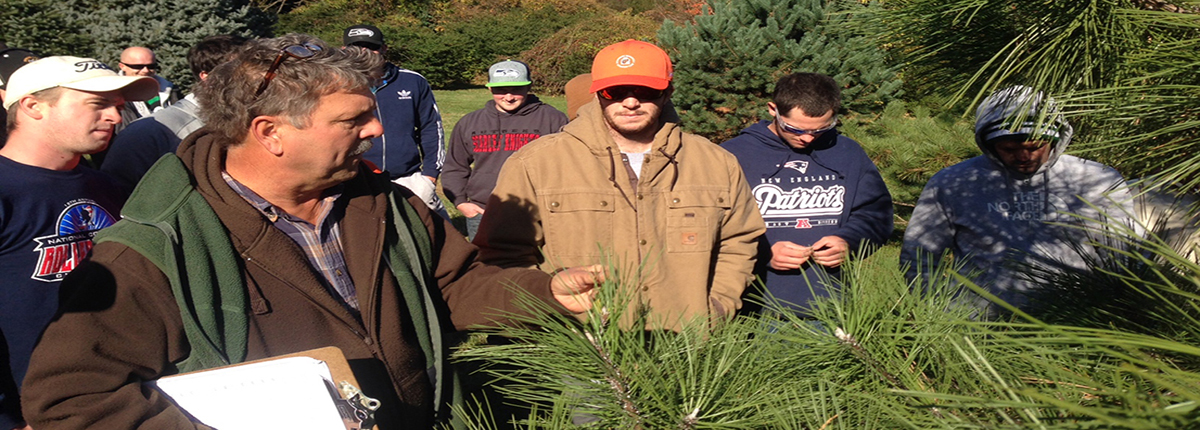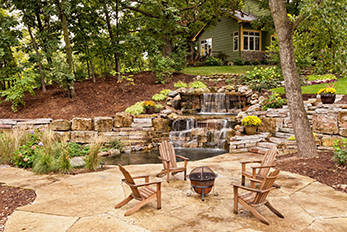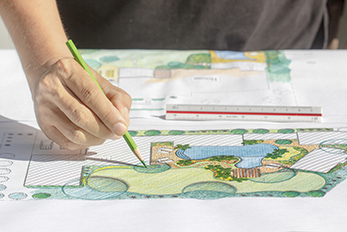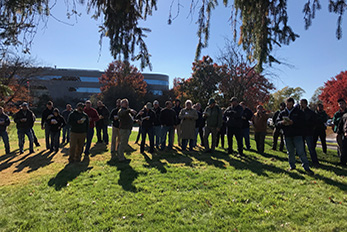Main Content

Course Status Notice – Not Scheduled
We do not have an offering of this course scheduled at this time. Please join our email list to be notified when the next offering is scheduled!
Jump to: Overview | Instructor | Reviews | CE Credits | Contact Us | Related Courses | Join Email List
Course Details
Course Name: Landscape Plants: Identification, Selection, and Application
Course Code: AL0201CA25
Date of Most Recent Offering: January 3 – March 14, 2025 (every Friday morning for 11 weeks)
Course Overview
![]() This class is part of the Landscape Management II Certificate Program.
This class is part of the Landscape Management II Certificate Program.
Are you ready to up your game? If you work with plants, you need to look smart doing it – and the best way to look smart is to know what they are, where to find them, and how to use them. This class will teach you more than you ever knew about landscape plants, and you’ll love every minute of it — including the hands-on plant identification walks, the comprehensive classroom lectures, and the online instructional tools!
Over the course of eleven consecutive Friday mornings, instructor Steven Kristoph will teach you two vital skills that all plant lovers and managers should master:
- The ability to identify landscape plants on the properties you manage
- Expanding your palette of plants to select the right plant for the right site and the right purpose
This course will cover a variety of different kinds of landscape plants, including shade trees, ornamental small trees, conifers, needle evergreens, broadleaf evergreens, rhododendrons and their kin, flowering shrubs, groundcover options, and rariflora. A full list is available below.
Whether you’re a landscaping professional or just a person who loves plants, this class is for you! Come dressed in winter wear and be prepared to go outside.
Please note: We recommend that you enroll in Introduction to Plant Identification prior to attending this program.
Course Video Preview
Learn more about what you can expect to learn in this course from instructor Steven Kristoph.
Plant Species Covered in this Course
Over the 11 sessions of this class, you will become familiar with over 200 plant species including shade trees, conifers, ornamental small trees, broadleaf evergreens, rhododendrons, deciduous shrubs and vines, groundcovers, and rariflora. A detailed list is available below – click on each heading to expand the full list of plants!
Shade Trees
- Norway Maple (Acer platanoides)
- Red Maple (Acer rubrum)
- Silver Maple (Acer saccharinum)
- Sugar Maple (Acer saccharum)
- River Birch (Betula nigra)
- Paper Birch, Canoe Birch (Betula papyrifera)
- European Birch (Betula pendula)
- Katsura Tree (Cercidiphyllum japonicum)
- American Beech (Fagus grandifolia)
- European Beech (Fagus sylvatica)
- Weeping European Beech (Fagus sylvatica ‘Pendula’)
- White Ash (Fraxinus americana)
- Green Ash (Fraxinus pennsylvanica)
- Ginkgo (Ginkgo biloba)
- Sweetgum (Liquidamber syraciflua)
- Blackgum (Nyssa sylvatica)
- Amur Cork Tree (Phellodendron amurense)
- London Plane Tree (Platanus x acerifolia)
- Sycamore (Platanus occidentalis)
- Sawtooth Oak (Quercus accutissima)
- White Oak (Quercus alba)
- Scarlet Oak (Quercus coccinea)
- Pin Oak (Quercus palustris)
- Red Oak (Quercus rubra)
- Golden Weeping Willow (Salix alba tristis)
- Japanese Pagoda Tree (Styphnolobium japonicum)
- Littleleaf Linden (Tilia cordata)
- Silver Linden (Tilia tomentosa)
- Japanese Zelkova (Zelkova serrata)
Fir, Cedar, Spruce, and Pine Trees
- White Fir (Abies concolor)
- Atlas Cedar (Cedrus atlantica)
- Blue Atlas Cedar (Cedrus atlantica ‘Glauca’)
- Cedar of Lebanon (Cedrus libani)
- Deodar Cedar (Cedrus deodara)
- Japanese Cryptomeria (Cryptomeria japonica)
- Norway Spruce (Picea abies)
- White Spruce (Picea glauca)
- Dwarf Alberta Spruce (Picea glauca ‘Conica’)
- Serbian Spruce (Picea omerika)
- Blue Colorado Spruce (Picea pungens ‘Glauca’)
- Colorado Spruce (Picea pungens)
- Douglas Fir (Pseudotsuga menziesii)
- Canadian Hemlock (Tsuga canadensis)
- White Pine (Pinus strobus)
- Japanese White Pine (Pinus parviflora)
- Himalayan Pine (Pinus wallichiana)
- Lacebark Pine (Pinus bungeana)
- Austrian Pine (Pinus nigra)
- Japanese Black Pine (Pinus thunbergiana)
- Scotch Pine (Pinus sylvestris)
Ornamental Small Trees
- Japanese Maple (Acer palmatum)
- Threadleaf Japanese Maple (Acer palmatum dissectum)
- Mimosa (Albizia julibrissin)
- Shadblow Serviceberry (Amelanchier arborea)
- Gray Birch (Betula populifolia)
- Flowering Dogwood (Cornus florida)
- Pink Flowering Dogwood (Cornus florida rubra)
- Japanese Dogwood (Cornus kousa)
- Rutgers Hybrid Dogwoods (Cornus x Stellar Series)
- Saucer Magnolia (Magnolia x soulangiana)
- Star Magnolia (Magnolia kobus var. stellata)
- Tea Crabapple (Malus hupehensis)
- Japanese Crabapple (Malus floribunda)
- Kwanzan Cherry (Prunus serrulata ‘Kwanzan’)
- Weeping Higan Cherry (Prunus subhirtella ‘Pendula’)
- Bradford Pear (Pyrus calleryana ‘Bradford’)
Ornamental Small Trees – East Meets West
- Paperbark Maple (Acer griseum)
- American Hornbeam (Carpinus caroliniana)
- Upright European Hornbeam (Carpinus betulus ‘Fastigiata’)
- Cockspur Hawthorn (Crataegus crus-galli)
- Washington Hawthorn (Crataegus phaenopyrum)
- Winter King Hawthorn (Crataegus viridis ‘Winter King’)
- Franklinia (Franklinia alatamaha)
- Common Witchhazel (Hamamelis virginiana)
- Vernal Witchhazel (Hamamelis vernalis)
- Hybrid Witchhazel (Hamamelis x intermedia)
- Golden Rain Tree (Koelreuteda paniculata)
- Sweetbay Magnolia (Magnolia virginiana)
- Sorrel Tree (Oxydendrum arboreum)
- Japanese Stewartia (Stewartia Pseudo-camellia)
- Japanese Tree Lilac (Syringa reticulata)
Lesser Conifers
- Hinoki Falsecypress (Chamaecyparis obtusa)
- Compact Hinoki Falsecypress (Chamaecyparis obtusa ‘Compacta’)
- Sawara Falsecypress (Chamaecyparis pisifera)
- Threadleaf Sawara Falsecypress (Chamaecyparis pisifera ‘Filifera’)
- Golden Threadleaf Sawara Falsecypress (Chamaecyparis pisifera ‘Filifera Aurea’)
- Dwarf Gold Mop Falsecypress (Chamaecyparis pisifera ‘Filifera Aurea Nana’)
- Leyland Cypress (X Cupressocyparis leylandii)
- American Arborvitae (Thuja occiqentalis)
- Oriental Arborvitae (Thuja orientalis)
- Pfitzer Juniper (Juniperus chinensis ‘Pfitzeriana’)
- Compact Pfitzer Juniper (Juniperus chinensis ‘Pfitzeriana Compacta’)
- Hetz Juniper (Juniperus chinensis ‘Hetzii’)
- Spiny Greek Juniper (Juniperus chinensis ‘Pyramidalis’)
- Eastern Red Cedar (Juniperus virginiana)
- Japanese Yew (Taxus cuspidata)
- Cap Yew (Taxus cuspidata ‘Capitata’)
- Dense Yew (Taxus x media ‘Densiformis’)
- Spreading English Yew (Taxus baccata ‘Repandens’)
Deciduous Conifers
- European Larch (Larix decidua)
- Dawn Redwood (Metasequoia glyptostroboides)
- Bald Cypress (Taxodium distichum)
Broadleaf Evergreens
- Japanese Aucuba (Aucuba japonica)
- Wintergreen Barberry (Berberis julianae)
- Boxwood (Buxus sempervirens)
- English Holly (Ilex aquifolium)
- Chinese Holly (Ilex cornuta)
- Nellie Stevens Holly (Ilex x ‘Nellie R. Stevens’)
- Japanese Holly (Ilex crenata)
- Convexleaf Holly (Ilex crenata ‘Convexa’)
- Heller Holly (Ilex crenata ‘Helleri’)
- Beehive Holly (Ilex crenata ‘Beehive’)
- lnkberry Holly (Ilex glabra)
- Meserve Hybrid Hollies (Ilex x meserveae)
- American Holly (Ilex opaca)
- Southern Magnolia (Magnolia grandiflora)
- Oregon Grapeholly Mahonia (Mahonia aquifolium)
- Leatherleaf Mahonia (Mahonia bealei)
- Japanese Skimmia (Skimmia japonica)
- Firethorn (Pyracantha coccinea)
- Leatherleaf Viburnum (Viburnum rhytidophyllym)
- Adams-Needle Yucca (Yucca filimentosa)
- Weakleaf Yucca (Yucca flaccida)
Rhododendron and Their Kin
- Mountain Laurel (Kalmia latifolia)
- Drooping Leucothoe (Leucothoe fontanesiana)
- Japanese Andromeda (Pieris japonica)
- Catawba Rhododendron (Rhododendron catawbiense)
- Rosebay Rhododendron (Rhododendron maximum)
- Snow Azalea (Rhododendron mucronatum)
- Kurume Azalea (Rhododendron obtusum)
- PJM Rhododendron (Rhododendron PJM)
Deciduous Shrubs and Vines
- Glossy Abelia (Abelia grandiflora)
- Red Chokeberry (Aronia arbutifolia)
- Rock Cotoneaster (Cotoneaster horizontalis)
- Winged Euonymus (Euonymus alatus)
- Compact Winged Euonymus or Burning Bush (Euonymus alatus ‘Compactus’)
- Border Forsythia (Forsythia x intermedia)
- Winterberry Holly (Ilex verticillata)
- Bigleaf Hydrangea (Hydrangea macrophylla)
- Crepe-myrtle (Lagerstroemia indica)
- Common Lilac (Syringa vulgaris)
- Korean Spice Viburnum (Viburnum carlesii)
- Linden Viburnum (Viburnum dilitatum)
- Double File Viburnum (Viburnum plicatum tomentosum)
- Japanese Creeper (Parthenocissus tricuspidata)
- Chinese Wisteria (Wisteria sinensis)
- Japanese Honeysuckle (Lonicera japonica)
- Clematis (Clematis x hybrids)
Groundcovers
- Carpet Bugle (Ajuga reptans)
- Bearberry (Arctostaphylos uva-ursi)
- Crownvetch (Coronilla varia)
- Rock Cotoneaster (Cotoneaster horizontalis)
- Bearberry Cotoneaster (Cotoneaster dammeri)
- Barrenwort (Epimedium spp.)
- Purpleleaf Wintercreeper (Euonymus fortunei ‘Coloratus’)
- Sweet Woodruff (Gallium odorata)
- Wintergreen (Gaultheria procumbens)
- English Ivy (Hedera helix)
- Baltic Ivy (Hedera helix var. baltica)
- Bird’s Foot Ivy (Hedera helix var. pedata)
- Daylilies (Hemerocallis spp.)
- Hostas (Hosta spp.)
- Candytuft (lberis sempervirens)
- Creeping Juniper (Juniperus horizontalis)
- Andorra Juniper (Juniperus horizontalis cv. plumosus)
- Bar Harbor Juniper (Juniperus horizontalis cv. Bar Harbor)
- Waukegan Juniper (Juniperus horizontalis cv. douglasi)
- Blue Rug Juniper (Juniperus horizontalis cv. wiltoni)
- Sargent’s Juniper (Juniperus chinensis sargentii)
- Shore Juniper (Juniperus conferta)
- Tam Juniper (Juniperus sabina tamariscifolia)
- Big Blue Lily-Turf (Liriope muscari)
- Hall’s Honeysuckle (Lonicera japonica ‘Halliana’)
- Pachysandra (Pachysandra terminalis)
- Ground Phlox (Phlox subulata)
- Gold Moss Stone Crop (Sedum acre)
- Two Row Stone Crop (Sedum spurium)
- Thyme (Thymus spp.)
- Periwinkle (Vinca minor)
Rariflora
- Japanese Maple (Acer palmatum)
- David’s Maple (Acer davidii)
- Fullmoon Maple (Acer japonicum)
- Nikko Maple (Acer maximowiczianum)
- Korean Maple (Acer pseudosieboldianum)
- Snakebark Maple (Acer rufinerve)
- Manchu-striped Maple (Acer tegmentosum)
- Beautyberry (Callicarpa spp.)
- Japanese Hornbeam (Carpinus cordata)
- Chinese Toon Tree (Cedrela sinensis)
- Harlequin Glorybower (Clerodendron trichotomum)
- Japanese Clethra (Clethra barbinervis)
- Cinnamon Clethra (Clethra acuminata)
- Daphne (Daphne spp.)
- Dove Tree (Davidia involucrata)
- Persimmon (Diospyros virginiana)
- Disanthus cercidifolius
- Redveined Enkianthus (Enkianthus campanulatus)
- White Enkianthus (Enkianthus perulatus)
- Dwarf Bottlebrush (Fothergilla gardenii)
- Large Bottlebrush (Fothergilla major)
- Carolina Silverbell (Halesia carolina)
- Virginia Sweetspire (Itea virginica)
- Persian Ironwood (Parrotia persica)
- Oriental Photinia (Photinia villosa)
- Chinese Quince (Pseudocydonia sinensis)
- Epaulette Tree (Pterostryrax hispidus)
- Umbrella Pine (Sciadopytis verticillata)
- Japanese Snowbell (Styrax japonicus)
- Sapphireberry (Symplocos paniculata)
- Prickly Ash (Zanthoxylum piperitum)
- Dusty Zenobia (Zenobia pulverulenta)
- California Incense Cedar (Libocedrus decurrens)
Earn a Digital Badge

Students who successfully complete this program will be issued a digital badge that details the course requirements. This badge is a great way to demonstrate the rigorous training you completed to prospective employers, schools, colleagues and peers. It can be added to your email signature, your LinkedIn profile, other social media accounts, or shared via URL. Visit our digital badge page for more information.
Who Should Attend?
Whether working with plants is your profession or your personal passion, this course will provide you with practical knowledge that you can apply to all of your landscape plans and projects! Even if you’ve “been in the business” for years, you’ll walk away with new information and insights. Here are some of the types of people who have taken Landscape Plants: Identification, Selection, and Application in the past:
- Garden Center Managers
- Garden Designers
- Groundskeepers
- Homeowners
- Horticultural Enthusiasts
- Landscape Architects
- Landscape Contractors
- Landscape Designers
- Landscape Managers/Foremen
- Landscape Professionals
- Landscape Superintendents
- Master Gardeners
- Nursery Professionals
- Property Managers
- Sales Representatives
Meet Your Instructors
Steve Kristoph, Steven Kristoph Nursery

Steve Kristoph is widely known for his encyclopedic knowledge of plant material. He received his Bachelors and Masters degrees in horticulture from Rutgers University, and he has been an adjunct instructor at Rutgers for over 25 years. He also owns and operates Steven Kristoph Nursery in Monmouth County, NJ, where he grows many types of ornamental trees, shrubs and herbaceous perennials. The landscaping division of his business, P. Steven Kristoph Garden Design, serves both residential and commercial customers and offers a full range of services, including design, installation, maintenance and seasonal color. Steve is passionate about plants and enjoys sharing his passion with others.
Student Reviews
“He [instructor Steven Kristoph] has forgotten more about landscaping plants than I will ever know!”
– M. Booth, Booth Brothers Landscaping
“This course is excellent. I’ve learned more in a few weeks than I have in years of landscaping.”
– Past Participant
“This class was highly inspirational. It completely changed the way I look at trees and plants.”
– Past Participant
Continuing Education Credits
The most recent offering of Landscape Plants: Identification, Selection, and Application was approved for the following credits from professional organizations. We will reapply for similar credits the next time the course runs, but we cannot guarantee credit approval for future offerings.
 New Jersey
New Jersey
NJ Certified Public Works Managers (CPWM): 8 Technical Contact Hours (course #DLGS-RUCPE23-21)
NJ Licensed Tree Experts (LTE/LTCO): 35.75 CEUs
NJ Urban and Community Forestry (NJUCF): 31 CEUs
 Meals
Meals
No meals will be provided at this course.
Program Questions? We’re Here to Help!
If you have any questions about Landscape Plants: Identification, Selection, and Application, please don’t hesitate to reach out to us.

Program Coordinator: Joe Canzano
848-932-7317
joe.canzano@rutgers.edu

Administrative Assistant: Damiana Parada
848-932-7107
damiana.parada@rutgers.edu
For registration assistance, please contact our Registration Department at 848-932-9271, option 2 or email registration@njaes.rutgers.edu.



